Whether you’re a beginner or an experienced player, understanding transposition is vital to expanding your musical repertoire. In this article, we will work through practical tips, techniques, and examples. Prepare to enhance your musical skills as we dive into transposition for alto sax.
The Alto Sax in Eb
One of the challenges of playing the alto sax is transposing the music written for other instruments. Transposing means changing the pitch of a piece of music to make it fit the range or key of another instrument. The Alto sax is a transposing instrument in the key of E flat. This means that when the alto sax plays a C on the staff, we hear the Eb below this, or major 6th below.
If you want to play a piece written for the C flute on the alto sax, you have to transpose it up a major 6th to make it sound at the same pitch level.
The other saxophones all have their own keys and will also require transposing to play together.
- Soprano – Bb – up a major 2nd to written pitch
- Alto – Eb = up a major 6th to written pitch
- Tenor Bb – C = Up a Major 9th to written pitch
- Baritone – Eb – C = Up a major 13th to written pitch
Later in this article we will look at transposing between different saxophones.
Transposition For Alto Sax Chart
Here is a handy chart for helping you with transposition for alto sax. You can use it to transpose a single note, for example C to A, or you can use it to transpose the key signature of a piece. For example a piece in D Major would transpose up a major 6th to B Major.
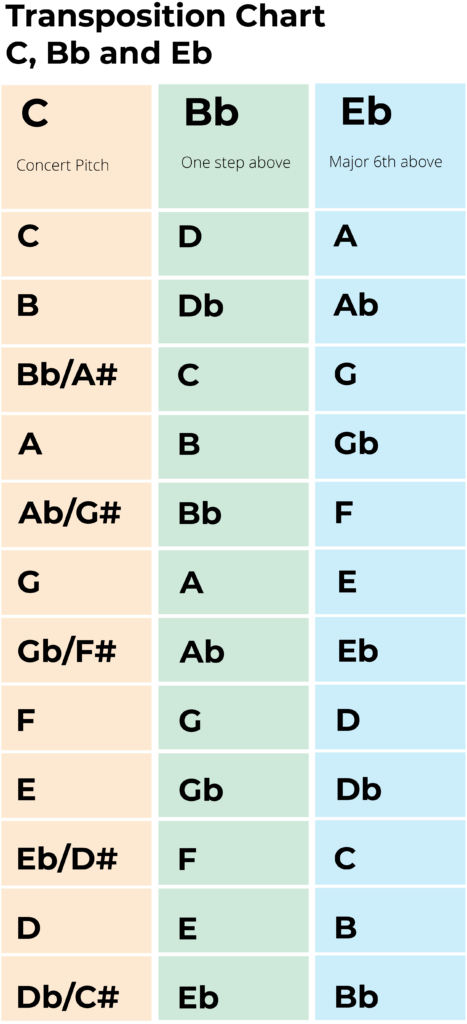
Transposition for alto sax to piano
The piano is a non-transposing instrument, or to put it another way, it is in the key of C. Whichever notes the pianist reads on the staff, we will hear exactly the same note. As the alto sax is in the key of E flat, we will need to transpose music for the piano up a Major 6th for the alto sax to play in the same key. Similarly, to play along with an alto sax on the piano, you would need to transpose the music down a major 6th for the piano part.
Transpose Eb to C
The alto sax, like all saxophones, is a transposing instruments. This means that when a player reads a C on the staff and play a C, we hear the Eb below. In other words, their written pitch is a major 6th above their sounding pitch.

If you play the alto sax and you want to compose music that harmonises with the piano, your sheet music will be a major 6th above the notes on the piano’s sheet music (or any other non-transposing instrument).
Or you may want to play an alto sax piece on a non-transposing instrument (like the flute). In this case you will have to lower each note a major 6th (9 half-steps). This will ensure it is heard in the same key as the alto sax.
Steps to Transpose Eb to C
Transposing from Eb to C involves up moving the notes up 9 half-steps or 4½ whole-step (tone). This is the same as moving up an interval of a Major 6th as C natural is the 6th note in the E flat major scale.
There are two different methods to transpose Eb to C.
Method 1- Move notes up one at a time
Have a look at the melody below.

The melody is written in key of D major. We could move all the notes up a 9 semitones, making sure that we take into account the F# and C# notes in the original key.

Here is the new melody. As you can see, we now only have three sharps in our new melody, but we are actually in the key of B Major (which has five sharps). Check out method 2, for a fool-proof method which clearly allows you to see the new key signature.

Method 2 – Transpose the key signature
- We could move up all the notes up a 6th
- Transpose the key signature up a major 6th
- Deal with any notes outside the original key
Look at the melody below.

It is in Ab major so we have Bb, Eb, Ab and Db. First let’s move all the notes up a 6th. Intervals always include the starting note so in effect, this means moving up five positions on the staff.

Now we can transpose our key signature. The major 6th above Ab is F. Another way to put this is that F natural is the 6th note of the A flat major scale. So our new key signature is F Major, which has one flat (Bb).
Here is our melody using transposition for alto sax, with the new key signature.

If there were any accidentals that were outside the original key of Ab, we would not use this method. Instead we would treat these as individual notes and transpose them on their own. So if we had a F# then this would move up to an D# (9 half-steps above).
How to transpose alto sax to tenor sax
The tenor sax is in the key of Bb and is a major 9th below from concert pitch. This means that when the tenor sax reads C on the staff and plays a C, we will hear the Bb 9 notes below!
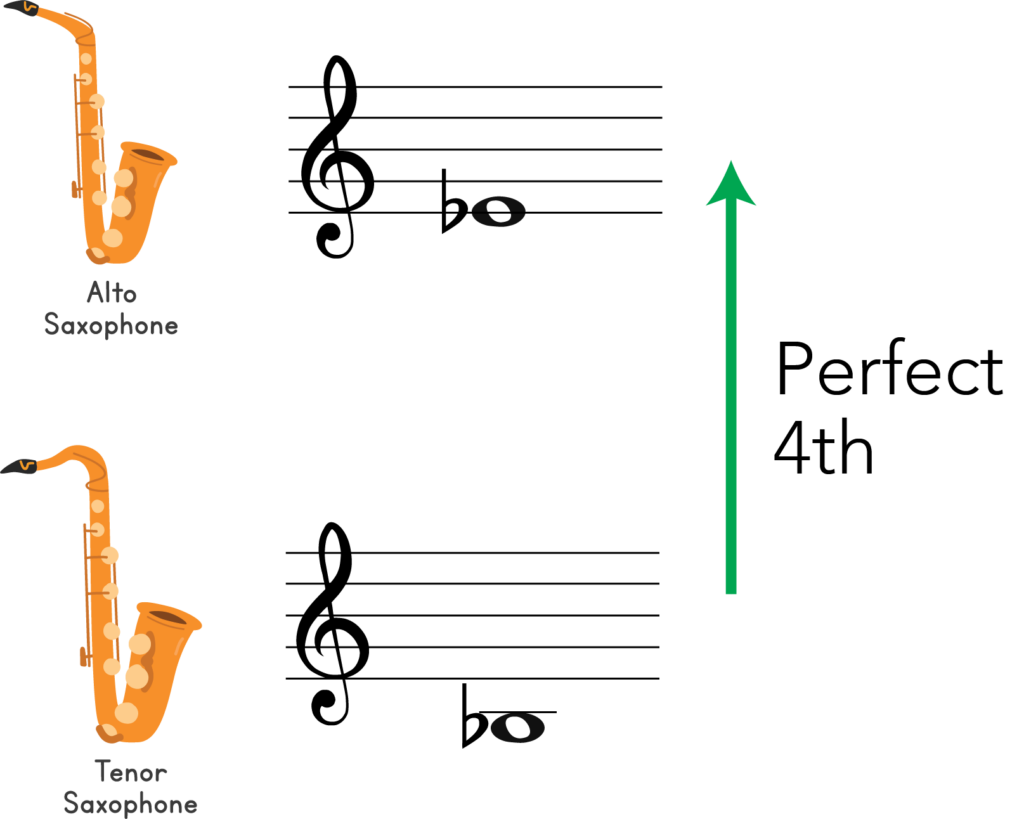
If we compare this to the alto sax we can see that we will be transposing between Eb (for the alto sax) and the Bb below this (for the tenor sax). Eb to Bb is a perfect 4th interval.
Transposition for alto sax to tenor sax.
- Transpose up a perfect 4th to play alto sax music on the tenor sax.
- Transpose down a perfect 4th to play tenor sax music on the alto sax.
For more check out our article on transposing down a perfect 4th and transposing up a perfect 4th.
How to transpose from Alto Sax to Flute
The standard flute is in the key of C and therefore not a transposing instrument. The alto sax is in the key of Eb which is a major 6th below.
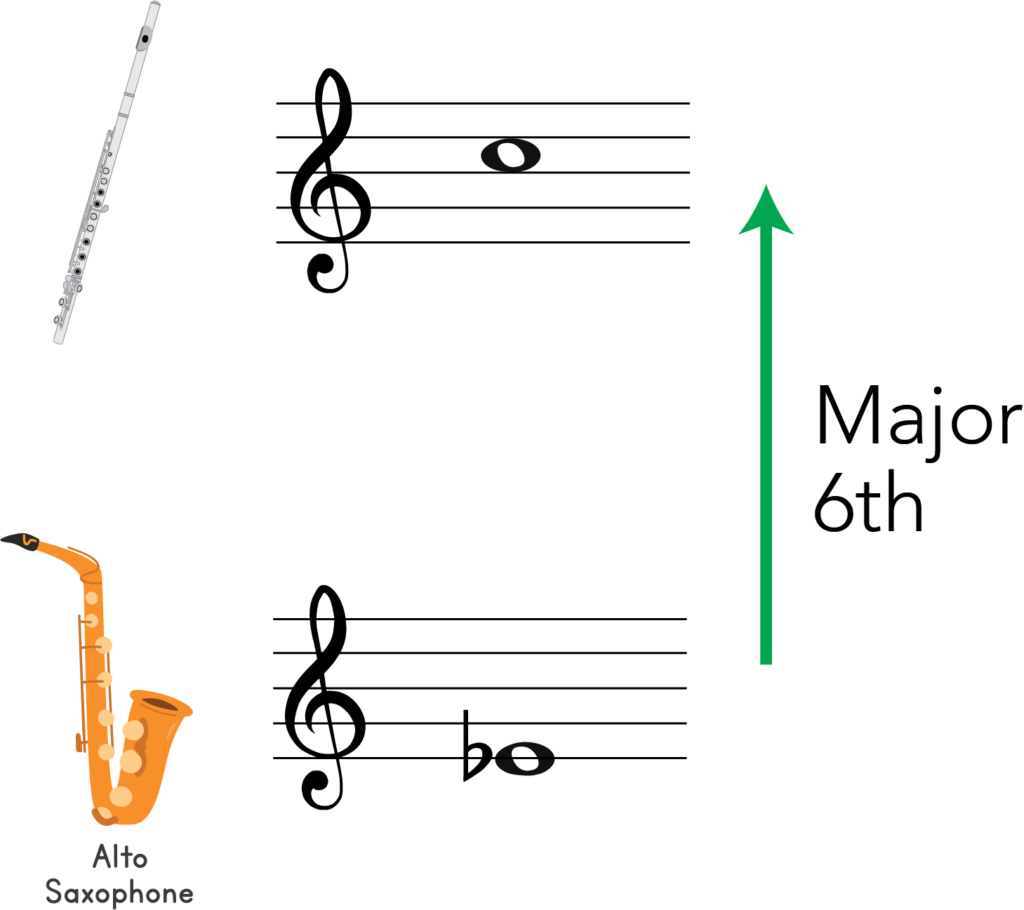
This means that we need to transpose flute music up a major 6th to play it on the alto sax. We could also transpose music for the alto sax down a major 6th to play it on the flute. See our example above for how to transpose by a major 6th.
How to transpose from Alto Sax to Guitar
The guitar is actually a transposing instrument because its sounding pitch is one octave below its written pitch. This means that when the guitar reads middle C on the stave, we will actually hear the C below this.
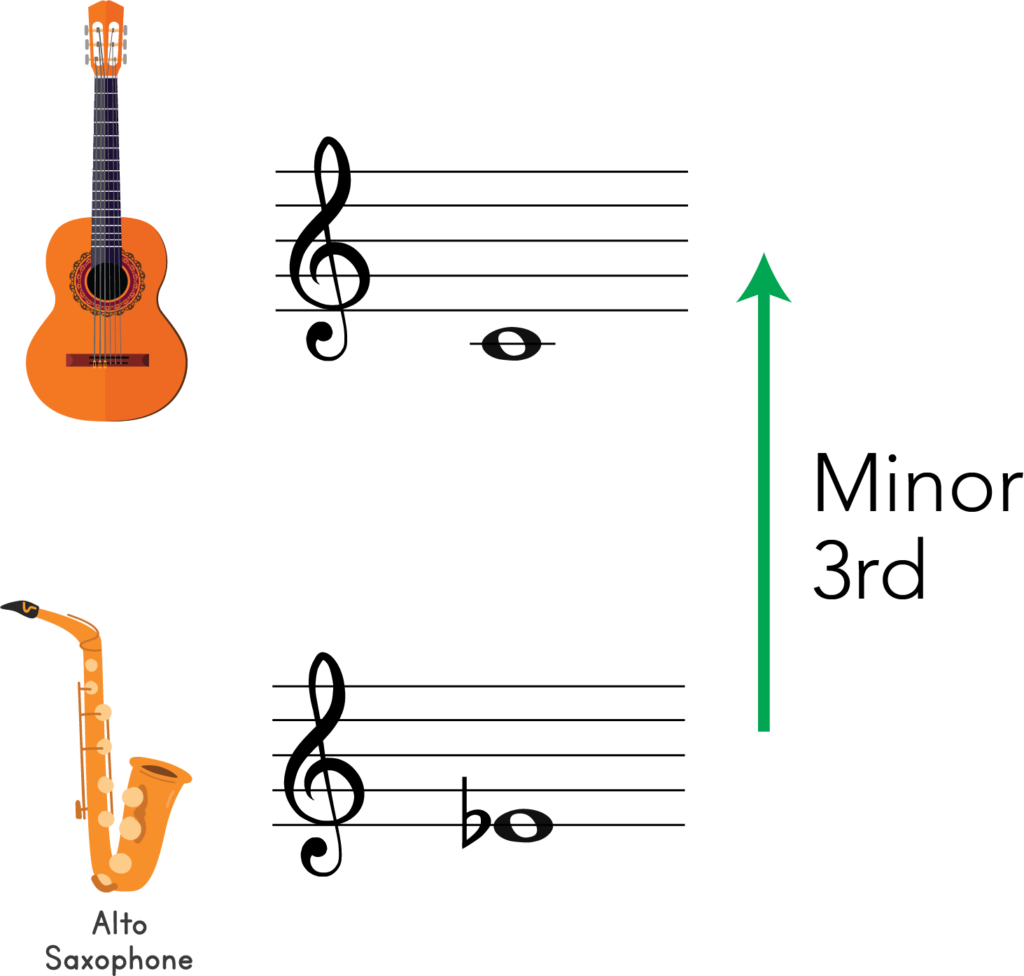
The alto sax is a transposing instrument in the key of Eb, so Eb to the C below gives us an interval of a Minor 3rd. This is because Eb is the 3rd note of the C minor scale.
Transposition for alto sax to guitar:
- Transpose up a Minor 3rd to play alto sax music on the guitar
- Transpose down a Minor 3rd to play guitar music on the alto sax.
To have both instrument harmonising in the same key, we need the alto sax part to be a minor 3rd below the guitar part.
So how do you transpose by a minor 3rd. We have two step-by-step guides to help: transpose up a minor 3rd and transpose down a Minor 3rd.
How to transpose alto sax to soprano sax
The soprano sax is a transposing instrument in B flat. This means that it is a major 2nd below concert pitch. The alto sax is also a transposing instrument in E flat (a Major 6th below concert pitch).
The interval of E flat to the B flat above is a perfect 5th. This is because Bb the 5th note of the Eb major scale.
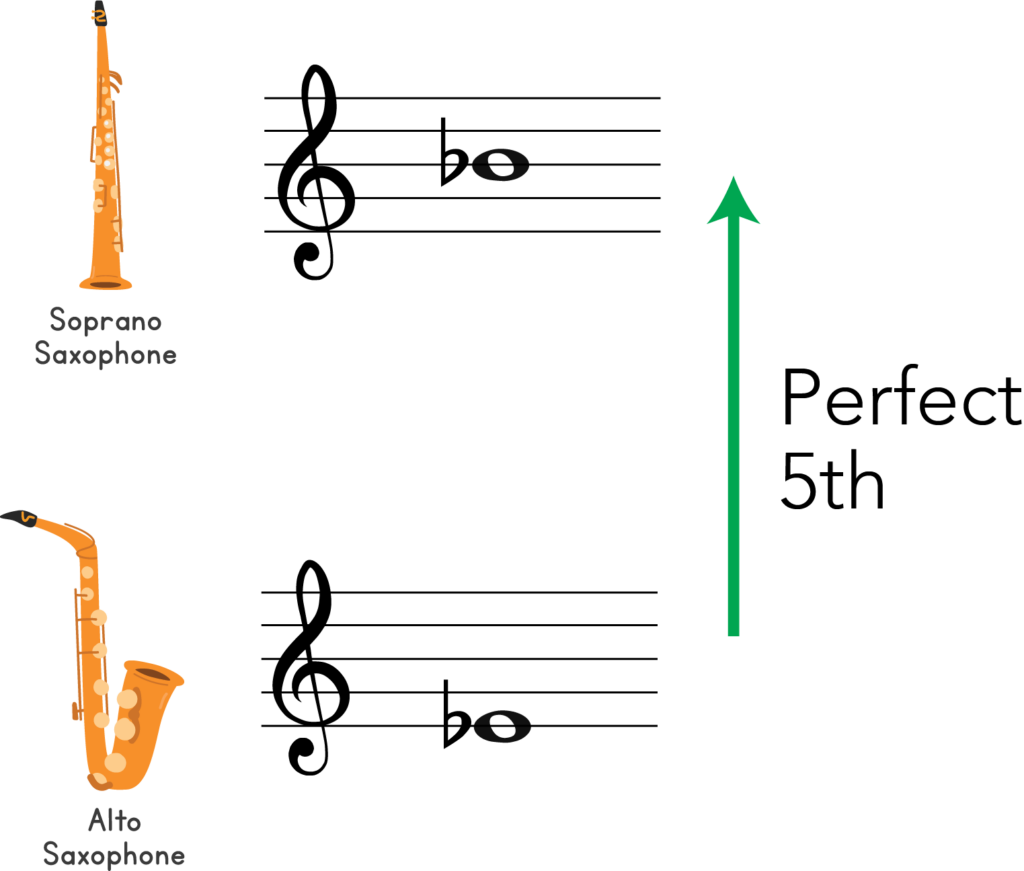
So why is transposing useful? Well, we might want to play music written for alto sax on the soprano saxophone or we might want to write harmonising parts for both instruments. By transposing by a perfect 5th we can do this.
Transposition for alto sax to soprano sax:
- Transpose up a perfect 5th to play soprano sax music on the alto sax.
- Transpose down a perfect 5th to play alto sax music on the soprano sax.
To have both instrument harmonising in the same key, we need the alto sax part to be a perfect 5th above the soprano sax part.
So how do you transpose by a perfect 5th. We have two step-by-step guides to help: transpose up a Perfect 5th and transpose down a Perfect 5th.
How to transpose alto sax to baritone sax
The baritone sax is a transposing instrument in E flat. This means that it is a major 13th below concert pitch. The alto sax is also a transposing instrument in E flat (a Major 6th below concert pitch).
The interval of E flat to the E flat above is an octave.
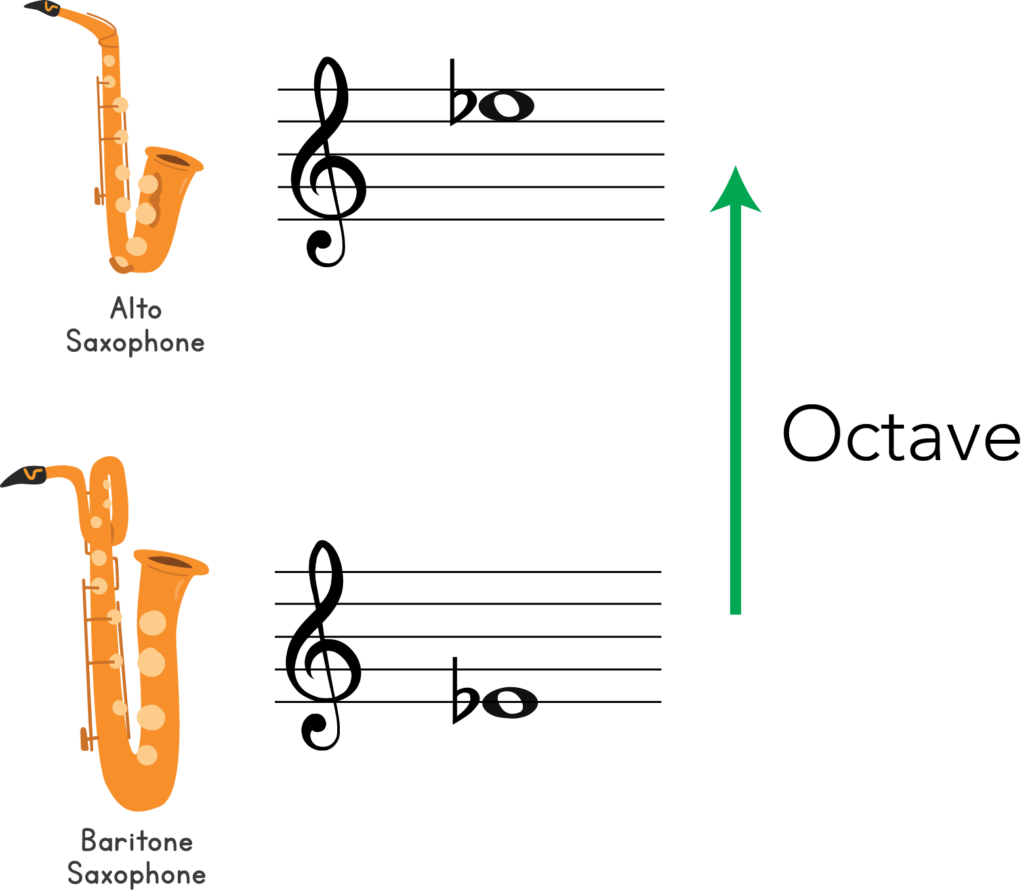
So why is transposing useful? Well, we might want to play music written for alto sax on the baritone saxophone or we might want to write harmonising parts for both instruments. By transposing by a octave we can do this.
Transposition for alto sax to baritone sax:
- Transpose down an octave to play baritone sax music on the alto sax.
- Transpose up an octave to play alto sax music on the baritone sax.
To have both instrument harmonising in the same key, we can keep both parts the same. The baritone will be in the same key but be playing an octave lower than the alto sax.
So how do you transpose by an octave? We have two step-by-step guides to help: transpose up an octave and transpose down an octave.
How to transpose Alto Sax to French Horn
The French Horn is a transposing instrument in the key of F. This means that it is a perfect 5th below concert pitch. The alto sax is also a transposing instrument in E flat (a Major 6th below concert pitch).
The interval of E flat to the F above is a Major 2nd.
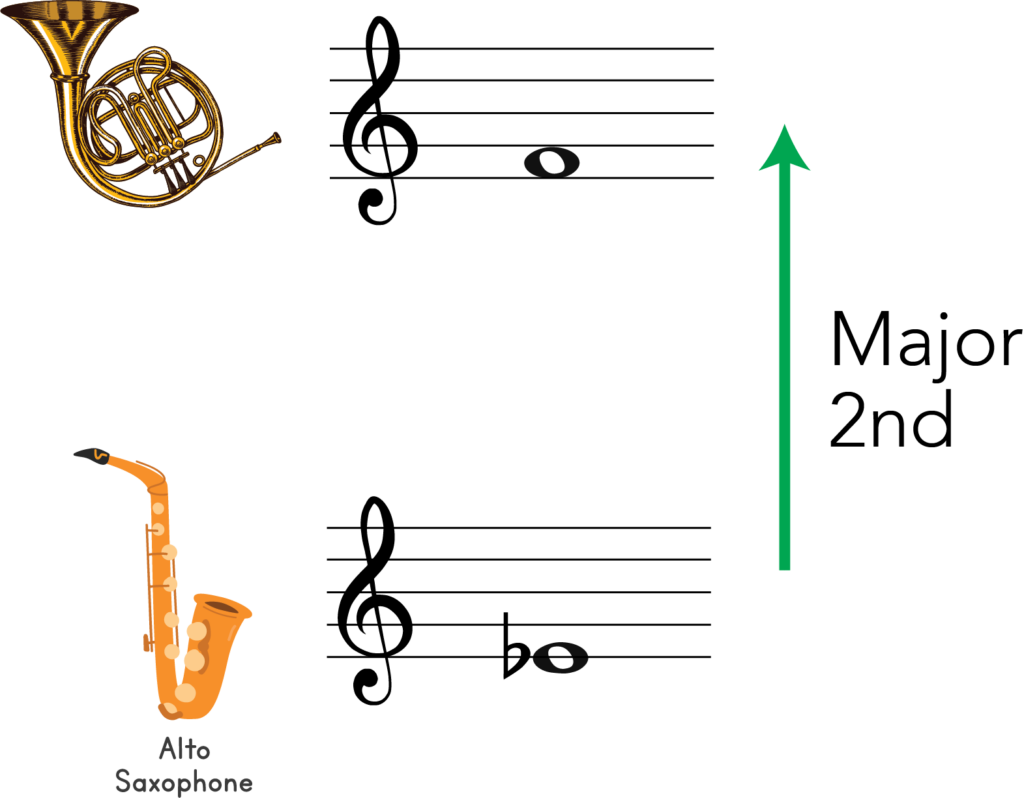
So why is transposing useful? Well, we might want to play music written for alto sax on the French horn or we might want to write harmonising parts for both instruments. By transposing by a Major 2nd we can do this.
Transposition for alto sax to French horn:
- Transpose up a Major 2nd to play French horn music on the Alto sax.
- Transpose down a Major 2nd to play Alto sax music on the French horn.
To have both instrument harmonising in the same key, we need the Alto sax part to be a Major 2nd above the French horn part.
So how do you transpose by a Major 2nd? We have two step-by-step guides to help: transpose up a Major 2nd and transpose down a Major 2nd.
Using computer software
A far quicker method of transposition is to use software to do it for you! Apps like Musescore, Sibelius and Finale will transpose whole pieces with the press of a few buttons. You can then export, print and share your new transposed sheet music.
What’s next….?
- Check out our guides to transposition
- Learn more about intervals with our guide to compound intervals.
